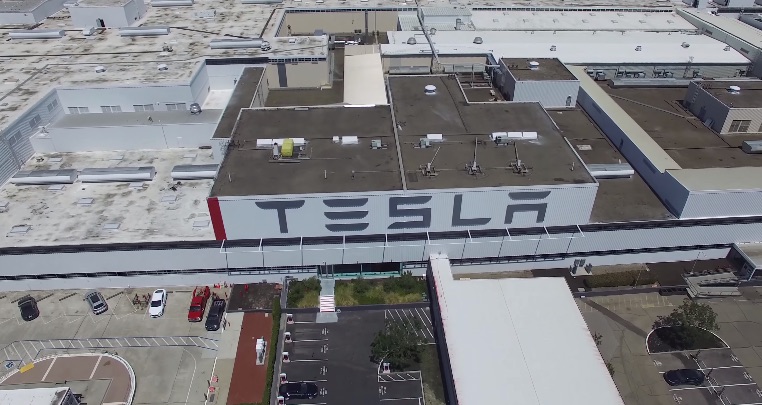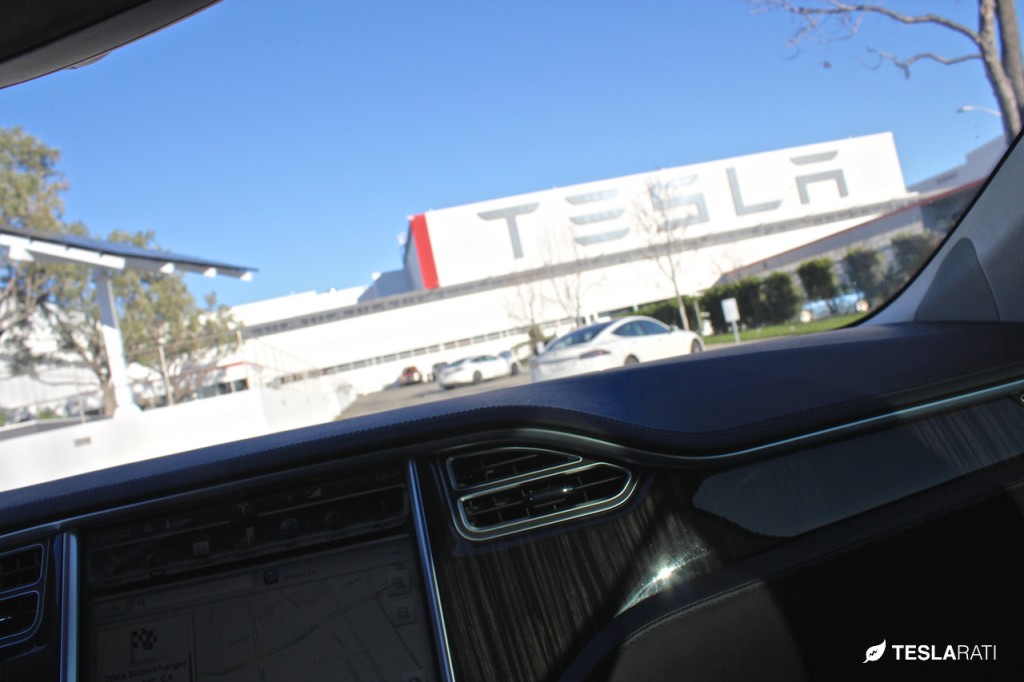News
Tesla implicated in foreign worker scandal after reports of visa violations
The San Jose Mercury finds that up to 140 low wage workers were used to build the new Tesla paint shop at the Fremont factory. They were supplied with phony B1/B2 visas by foreign companies.

Updated: Tesla has issued a response to the story which can be seen here.
Tesla is justly proud of its new state-of-the-art painting facility capable of scaling up to 500,000 vehicles per year at the Fremont factory, but a report coming from the San Jose Mercury published on May 15 says that underpaid foreign workers contributed to the construction of the paint shop violating terms of their B1/B2 visas.
The Mercury began its investigation after Gregor Lesnik, a native of Slovenia who worked on the expansion of Tesla’s multimillion dollar Fremont factory paint shop in 2015, filed suit against Tesla and several other defendants. Lesnik was seriously injured while working on the paint shop project after slipping on loose tile and falling three stories before breaking both legs, ribs, and sustaining a concussion.
The newspaper reports that in 2014, Lesnik was an unemployed electrician living with his mother in Velenje, Slovenia. His girlfriend was expecting their first child and money was tight. He saw an ad seeking workers placed by ISM Vuzen, a construction company located in Slovenia. Vuzem provides teams of Eastern European workers to build manufacturing plants in Europe and the U.S. Among its clients are Mercedes-Benz, Toyota, Volkswagen, Ford, and Saab.
In March, 2015, Tesla selected Eisenmann, a German-based manufacturer of industrial systems, to expand the Fremont paint shop. Eisenmann claimed it was the most valuable contract in its history at $100 million. Soon it began hiring subcontractors to fill out the work force for the project. It turned to Vuzen for some of those workers.
Vuzen helped Lesnik apply for a US visa. Eisenmann assisted. Robert Keller, its US purchasing manager based out of Chicago, was listed as Lesnik’s U.S. contact. After Lesnik filed his lawsuit, Eisenmann denied that it had any legal responsibility for him.
US immigration officials were told that Lesnik was a supervisor with specialized training who would be working at a paint shop for a BMW factory in South Carolina. Keller told INS in a letter that Lesnik was a “supervisor of electrical and mechanical installation. His assignment will involve multiple border entries,” Keller wrote, “but in no way adversely affect the employment of citizens of the United States.”
That couldn’t be further from the truth, says Rob Stoker, president of the Building and Construction Trades Council of Alameda County. “There’s definitely something wrong with this picture.” He claims a local company lost the bid on the Tesla project party because their labor costs were higher. The job would have meant tens of thousands of work hours and valuable training for local apprentices. “It killed us,” Stoker said. “We had so many people — ready, willing and able — needing this.”
For Lesnik and his fellow employees provided by Vuzen, the work in Fremont paid an average of $5 an hour with no benefits. They often worked 12 hour days, sometimes 7 days a week. He claims that Tesla employees who he worked side by side with were earning up to 10 times as much.
Tesla denies any responsibility for Lesnik, his injuries, or his immigration status. A company spokesperson told the Mercury, “Tesla expects all its contractors and their subs … to comply with all applicable pay laws.” Of course they do. But the real question is, how closely do they look at the status of people working at their facilities?
As with similar worker abuse issues that have beset other companies, such as Apple’s troubles with Foxconn, it is one thing to have high expectations. It is quite another to take adequate steps to ensure those expectations are met. All too often, it is easier to look the other way, especially when millions of dollars are involved.
Source and photo credit: San Jose Mercury

News
Tesla is not sparing any expense in ensuring the Cybercab is safe
Images shared by the longtime watcher showed 16 Cybercab prototypes parked near Giga Texas’ dedicated crash test facility.

The Tesla Cybercab could very well be the safest taxi on the road when it is released and deployed for public use. This was, at least, hinted at by the intensive safety tests that Tesla seems to be putting the autonomous two-seater through at its Giga Texas crash test facility.
Intensive crash tests
As per recent images from longtime Giga Texas watcher and drone operator Joe Tegtmeyer, Tesla seems to be very busy crash testing Cybercab units. Images shared by the longtime watcher showed 16 Cybercab prototypes parked near Giga Texas’ dedicated crash test facility just before the holidays.
Tegtmeyer’s aerial photos showed the prototypes clustered outside the factory’s testing building. Some uncovered Cybercabs showed notable damage and one even had its airbags engaged. With Cybercab production expected to start in about 130 days, it appears that Tesla is very busy ensuring that its autonomous two-seater ends up becoming the safest taxi on public roads.
Prioritizing safety
With no human driver controls, the Cybercab demands exceptional active and passive safety systems to protect occupants in any scenario. Considering Tesla’s reputation, it is then understandable that the company seems to be sparing no expense in ensuring that the Cybercab is as safe as possible.
Tesla’s focus on safety was recently highlighted when the Cybertruck achieved a Top Safety Pick+ rating from the Insurance Institute for Highway Safety (IIHS). This was a notable victory for the Cybertruck as critics have long claimed that the vehicle will be one of, if not the, most unsafe truck on the road due to its appearance. The vehicle’s Top Safety Pick+ rating, if any, simply proved that Tesla never neglects to make its cars as safe as possible, and that definitely includes the Cybercab.
Elon Musk
Tesla’s Elon Musk gives timeframe for FSD’s release in UAE
Provided that Musk’s timeframe proves accurate, FSD would be able to start saturating the Middle East, starting with the UAE, next year.

Tesla CEO Elon Musk stated on Monday that Full Self-Driving (Supervised) could launch in the United Arab Emirates (UAE) as soon as January 2026.
Provided that Musk’s timeframe proves accurate, FSD would be able to start saturating the Middle East, starting with the UAE, next year.
Musk’s estimate
In a post on X, UAE-based political analyst Ahmed Sharif Al Amiri asked Musk when FSD would arrive in the country, quoting an earlier post where the CEO encouraged users to try out FSD for themselves. Musk responded directly to the analyst’s inquiry.
“Hopefully, next month,” Musk wrote. The exchange attracted a lot of attention, with numerous X users sharing their excitement at the idea of FSD being brought to a new country. FSD (Supervised), after all, would likely allow hands-off highway driving, urban navigation, and parking under driver oversight in traffic-heavy cities such as Dubai and Abu Dhabi.
Musk’s comments about FSD’s arrival in the UAE were posted following his visit to the Middle Eastern country. Over the weekend, images were shared online of Musk meeting with UAE Defense Minister, Deputy Prime Minister, and Dubai Crown Prince HH Sheikh Hamdan bin Mohammed. Musk also posted a supportive message about the country, posting “UAE rocks!” on X.
FSD recognition
FSD has been getting quite a lot of support from foreign media outlets. FSD (Supervised) earned high marks from Germany’s largest car magazine, Auto Bild, during a test in Berlin’s challenging urban environment. The demonstration highlighted the system’s ability to handle dense traffic, construction sites, pedestrian crossings, and narrow streets with smooth, confident decision-making.
Journalist Robin Hornig was particularly struck by FSD’s superior perception and tireless attention, stating: “Tesla FSD Supervised sees more than I do. It doesn’t get distracted and never gets tired. I like to think I’m a good driver, but I can’t match this system’s all-around vision. It’s at its best when both work together: my experience and the Tesla’s constant attention.” Only one intervention was needed when the system misread a route, showcasing its maturity while relying on vision-only sensors and over-the-air learning.
News
Tesla quietly flexes FSD’s reliability amid Waymo blackout in San Francisco
“Tesla Robotaxis were unaffected by the SF power outage,” Musk wrote in his post.

Tesla highlighted its Full Self-Driving (Supervised) system’s robustness this week by sharing dashcam footage of a vehicle in FSD navigating pitch-black San Francisco streets during the city’s widespread power outage.
While Waymo’s robotaxis stalled and caused traffic jams, Tesla’s vision-only approach kept operating seamlessly without remote intervention. Elon Musk amplified the clip, highlighting the contrast between the two systems.
Tesla FSD handles total darkness
The @Tesla_AI account posted a video from a Model Y operating on FSD during San Francisco’s blackout. As could be seen in the video, streetlights, traffic signals, and surrounding illumination were completely out, but the vehicle drove confidently and cautiously, just like a proficient human driver.
Musk reposted the clip, adding context to reports of Waymo vehicles struggling in the same conditions. “Tesla Robotaxis were unaffected by the SF power outage,” Musk wrote in his post.
Musk and the Tesla AI team’s posts highlight the idea that FSD operates a lot like any experienced human driver. Since the system does not rely on a variety of sensors and a complicated symphony of factors, vehicles could technically navigate challenging circumstances as they emerge. This definitely seemed to be the case in San Francisco.
Waymo’s blackout struggles
Waymo faced scrutiny after multiple self-driving Jaguar I-PACE taxis stopped functioning during the blackout, blocking lanes, causing traffic jams, and requiring manual retrieval. Videos shared during the power outage showed fleets of Waymo vehicles just stopping in the middle of the road, seemingly confused about what to do when the lights go out.
In a comment, Waymo stated that its vehicles treat nonfunctional signals as four-way stops, but “the sheer scale of the outage led to instances where vehicles remained stationary longer than usual to confirm the state of the affected intersections. This contributed to traffic friction during the height of the congestion.”
A company spokesperson also shared some thoughts about the incidents. “Yesterday’s power outage was a widespread event that caused gridlock across San Francisco, with non-functioning traffic signals and transit disruptions. While the failure of the utility infrastructure was significant, we are committed to ensuring our technology adjusts to traffic flow during such events,” the Waymo spokesperson stated, adding that it is “focused on rapidly integrating the lessons learned from this event, and are committed to earning and maintaining the trust of the communities we serve every day.”










